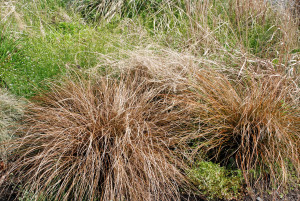
Maybe you’ve inherited a lawn that has fallen into disrepair, or maybe you’ve just been bitten by the lazy bug! Whatever the reason, knowing how to cut a seriously overgrown lawn can be more tricky than it first seems, it certainly won’t just be a case of quickly zipping round with the mower. You’ll need patience and a little bit of elbow grease but it’s certainly possible to achieve on your own. If you wish to hire a commercial lawn care company to take care of it that’s certainly an option, just bare in mind it’s likely to be pretty pricey for what is effectively a ‘clean up’ job.
Assuming you choose to take the task on yourself, you’ll need two items to give you the best shot at success:
- Strimmer or ‘Brush Cutter’
- Scythe
Now you don’t necessarily need both but bare in mind that a scythe will take care of grass up to a metre tall without any trouble, and without the mess and noise of a strimmer, but if choosing between one or the other a strimmer is ultimately going to be of most use. If you don’t feel that you can justify the expense of buying one there are many good garden machinery hire companies around who will be able to give you friendly help and advice, as well of course as a reasonable price for renting a powerful strimmer for a day or two. Note if you do go down the strimmer route, you might find a ‘brush cutter’ blade will be more effective at cutting through large amounts of grass, as these are more powerful than a conventional nylon string, or thin steel blade, both of which may break.
Removing the grass one layer at a time
Armed with your new cutting tool(s) you should approach the task of cutting systematically, ie. don’t just go in all guns blazing, hacking away at the grass in every direction, you’ll be left with more of a mess than you started with, making it much harder to determine what to do next. Instead take a uniform top layer off, leaving a sensible amount (perhaps 10cm) that can be finished off with a lawn mower later.
Once you’ve carried out this first trim it’s advisable to water the lawn and leave it for a week or so to recover, as you’ll probably notice that although the grass was long, what’s left behind is thin and tired looking.
When you return after a week or so it will be time to get the mower out, it’s most advisable to use a petrol lawn mower as this will have no issues with the thick overgrowth, whereas an electric mower may tend to jam. When mowing it’s advisable to set the mower to the highest setting and to do your best to keep things even. Even once you finish this second pass the lawn will still be in a very sorry state, but this will improve over the following weeks as it continues to recover.
If it doesn’t look as though this process alone will fix the problem it may be necessary to scarify the lawn, this will get rid of moss and thatch that might be preventing the lawn from recovering properly.


